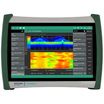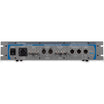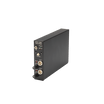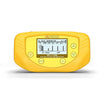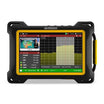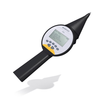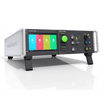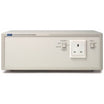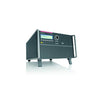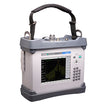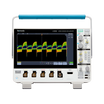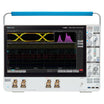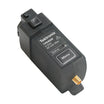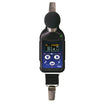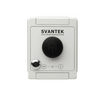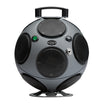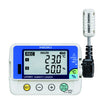
GRAS 40AN 1/2" Ext. Polarized Free-field Microphone, Low Frequency
Use our chat for personal support or contact us via +45 31 33 18 19 or salg@GOmeasure.dk
GRAS 40AN is a high-precision condenser microphone made according to IEC 61094-4 requirements. The 40AN’s design is based on the similar GRAS 40AF ½” free-field microphone, but optimized for low-frequency measurements. The cut-off frequency is as low as 0.5 Hz and obtained by modifying the equalization.
Discover the possibilities
More information
Description
GRAS 40AN 1/2" Ext. Polarized Free-field Microphone, Low Frequency
Introduction
GRAS 40AN is a high-precision condenser microphone made according to IEC 61094-4 requirements. The 40AN’s design is based on the similar GRAS 40AF ½” free-field microphone, but optimized for low-frequency measurements. The cut-off frequency is as low as 0.5 Hz and obtained by modifying the equalization.40AN is individually factory-calibrated and delivered with a calibration chart stating its specific open-circuit sensitivity, pressure, and corrected free-field frequency responses.
Typical applications and use
The low-frequency property combined with its high sensitivity and robust design make 40AN the obvious choice for infra-sound measurements—a fast growing discipline following the need for monitoring and reducing low-frequency noise from, for example, power and production plants and the increasing number of wind turbines.Compatibility
The 40AN requires a standardized ½” or ¼” LEMO preamplifier and an input module that supports this technology with a 7-pin LEMO connector.Note that to benefit from 40AN’s low frequency capabilities, it is important that the microphone preamplifier, analyzer input module, or sound level meter is designed to match 40AN.
System verification
For daily verification and check of your measurement setup, we recommend using a calibrator like GRAS 42AG Sound Level Calibrator.For proper sensitivity calibration, we recommend using a pistonphone like GRAS 42AP.
Calibration
When leaving the factory, all GRAS microphones have been calibrated in a controlled laboratory environment using traceable calibration equipment. Depending on the use, measurement environment and internal quality control programs we recommend that the microphone is recalibrated at least once a year.We offer two kinds of calibration as an optional after-sales service: GRAS Traceable Calibration and GRAS Accredited Calibration.
GRAS Traceable Calibration is a traceable calibration performed by trained personnel under controlled conditions according to established procedures and standards. This is identical to the rigorous calibration that all GRAS microphones are subjected to as an integral part of our quality assurance.
GRAS Accredited Calibration is performed by the GRAS Accredited Calibration Laboratory that has been accredited in accordance with ISO 17025 by DANAK, the Danish Accreditation Fund.
If you want a new microphone set delivered with an accredited calibration in stead of the default factory calibration, specify this when ordering.
Learn more at gras/calib.
Quality and warranty
All GRAS microphones are made of high-quality materials that will ensure life-long stability and robustness. The microphones are all assembled in verified clean-room environments by skilled and dedicated operators with many years of expertise in this field.The microphone diaphragm, body, and improved protection grid are made of high-grade stainless steel, which makes the microphone resistant to physical damage, as well as corrosion caused by aggressive air or gasses.
This, combined with the reinforced gold-plated microphone terminal which guarantees a highly reliable connection, enables GRAS to offer 5 years warranty against defective materials and workmanship.
Service
If you accidentally damage the diaphragm on a GRAS microphone, we can—in most cases—replace it at a very reasonable cost and with a short turn-around time. This not only protects your investment, but also pleases your quality assurance department because you don’t have to worry about new serial numbers, etc.Specifications
Documents
GRAS 40AN 1/2" Ext. Polarized Free-field Microphone, Low Frequency
GRAS 40AN 1/2" Ext. Polarized Free-field Microphone, Low Frequency datasheetOptions
Video
GRAS 40AN 1/2" Ext. Polarized Free-field Microphone, Low Frequency
Introduction
GRAS 40AN is a high-precision condenser microphone made according to IEC 61094-4 requirements. The 40AN’s design is based on the similar GRAS 40AF ½” free-field microphone, but optimized for low-frequency measurements. The cut-off frequency is as low as 0.5 Hz and obtained by modifying the equalization.40AN is individually factory-calibrated and delivered with a calibration chart stating its specific open-circuit sensitivity, pressure, and corrected free-field frequency responses.
Typical applications and use
The low-frequency property combined with its high sensitivity and robust design make 40AN the obvious choice for infra-sound measurements—a fast growing discipline following the need for monitoring and reducing low-frequency noise from, for example, power and production plants and the increasing number of wind turbines.Compatibility
The 40AN requires a standardized ½” or ¼” LEMO preamplifier and an input module that supports this technology with a 7-pin LEMO connector.Note that to benefit from 40AN’s low frequency capabilities, it is important that the microphone preamplifier, analyzer input module, or sound level meter is designed to match 40AN.
System verification
For daily verification and check of your measurement setup, we recommend using a calibrator like GRAS 42AG Sound Level Calibrator.For proper sensitivity calibration, we recommend using a pistonphone like GRAS 42AP.
Calibration
When leaving the factory, all GRAS microphones have been calibrated in a controlled laboratory environment using traceable calibration equipment. Depending on the use, measurement environment and internal quality control programs we recommend that the microphone is recalibrated at least once a year.We offer two kinds of calibration as an optional after-sales service: GRAS Traceable Calibration and GRAS Accredited Calibration.
GRAS Traceable Calibration is a traceable calibration performed by trained personnel under controlled conditions according to established procedures and standards. This is identical to the rigorous calibration that all GRAS microphones are subjected to as an integral part of our quality assurance.
GRAS Accredited Calibration is performed by the GRAS Accredited Calibration Laboratory that has been accredited in accordance with ISO 17025 by DANAK, the Danish Accreditation Fund.
If you want a new microphone set delivered with an accredited calibration in stead of the default factory calibration, specify this when ordering.
Learn more at gras/calib.
Quality and warranty
All GRAS microphones are made of high-quality materials that will ensure life-long stability and robustness. The microphones are all assembled in verified clean-room environments by skilled and dedicated operators with many years of expertise in this field.The microphone diaphragm, body, and improved protection grid are made of high-grade stainless steel, which makes the microphone resistant to physical damage, as well as corrosion caused by aggressive air or gasses.
This, combined with the reinforced gold-plated microphone terminal which guarantees a highly reliable connection, enables GRAS to offer 5 years warranty against defective materials and workmanship.

